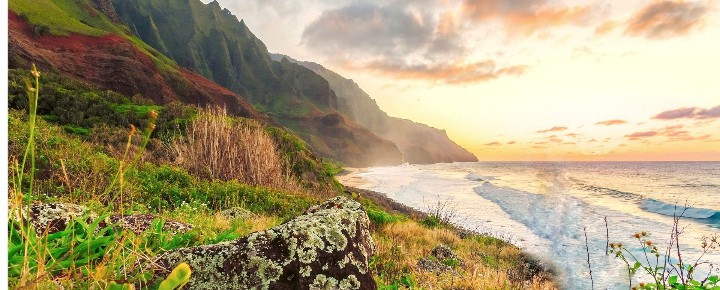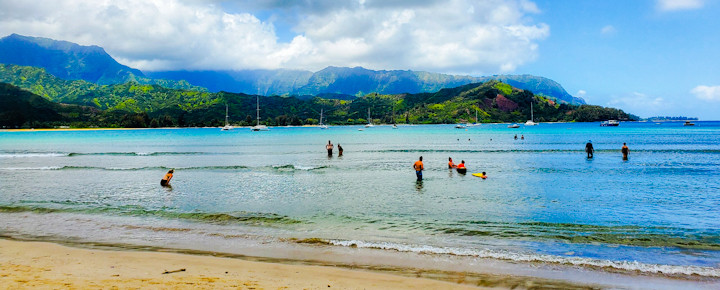Hawaii without tourism? What would that look like? Let SIXT.VN, your travel expert, guide you through the potential impacts and explore alternative paths for this beautiful island paradise. Discover how strategic tourism and diversified industries can create a balanced and sustainable future for Hawaii. Let’s explore eco-friendly travel packages, cultural immersion tours, and ways to support local communities, ensuring a brighter future for Hawaii.
1. What Economic Disruptions Would Hawaii Face Without Tourism?
Hawaii’s economy would face significant disruptions without tourism. According to the Hawaii Department of Business, Economic Development & Tourism (DBEDT), tourism accounts for approximately 21% of Hawaii’s economy. Without this revenue, the state would need to find alternative sources of income and restructure its economy. This could involve:
- Increased Taxes: Higher taxes on residents and businesses to compensate for lost tourism revenue.
- Job Losses: Significant job losses in the hospitality, retail, and transportation sectors.
- Reduced Government Services: Cuts in public services such as education, healthcare, and infrastructure projects.
- Real Estate Market Decline: A decrease in property values due to reduced demand from tourists and investors.
2. How Would Hawaii’s Employment Landscape Shift Without Tourism?
The employment landscape in Hawaii would drastically shift without tourism. The Bureau of Labor Statistics (BLS) reports that tourism supports hundreds of thousands of jobs in Hawaii. Without this industry, many residents would need to seek employment in other sectors. This could lead to:
- Unemployment Surge: A sharp increase in unemployment rates as tourism-related businesses close or downsize.
- Sector Diversification: A need for workers to retrain and find jobs in emerging industries such as technology, renewable energy, and agriculture.
- Wage Reductions: Potential wage reductions as the labor market becomes more competitive.
- Entrepreneurial Opportunities: An increase in entrepreneurship as individuals seek to create new businesses and services to meet the changing needs of the local economy.
3. What Changes in Hawaii’s Infrastructure and Services Can Be Expected?
Significant changes in Hawaii’s infrastructure and services could be expected without tourism. The state’s infrastructure is largely designed to support the needs of millions of annual visitors. Without this demand, Hawaii would need to reassess and potentially downsize its infrastructure and services. This could involve:
- Reduced Airport Traffic: Less air traffic and potentially the closure of some airport facilities.
- Lower Demand for Accommodations: Fewer hotels and resorts, leading to potential closures or conversions of these properties.
- Decrease in Transportation Services: Reduced demand for rental cars, taxis, and tour buses.
- Changes in Retail and Dining: Closure of many tourist-oriented shops and restaurants, with a shift towards businesses catering to local residents.
4. How Would Hawaii’s Natural Environment Be Affected By The Absence of Tourism?
The absence of tourism could have both positive and negative effects on Hawaii’s natural environment. On one hand, reduced tourism could lead to:
- Reduced Pollution: Less air and water pollution from transportation, hotels, and recreational activities.
- Ecosystem Recovery: Opportunities for ecosystems to recover from the impacts of over-tourism.
- Conservation Efforts: Increased focus on conservation efforts to protect Hawaii’s unique biodiversity.
However, the absence of tourism could also lead to:
- Funding Shortages: Reduced funding for conservation and environmental protection programs due to lower tax revenues.
- Neglect of Natural Sites: Potential neglect of natural sites if there are insufficient resources to maintain them.
- Increased Local Consumption: Increased pressure on local resources as residents rely more heavily on local agriculture and fisheries.
 Hanauma Bay, Hawaii
Hanauma Bay, Hawaii
Hanauma Bay’s landscape displays the effects of the summer tourist season during the COVID-19 pandemic.
5. How Would Hawaii’s Culture Be Impacted Without Tourist Influence?
Hawaii’s culture would likely undergo significant changes without the influence of tourism. While tourism has helped to preserve certain aspects of Hawaiian culture, it has also led to commodification and cultural appropriation. Without tourism, there could be:
- Cultural Preservation: A greater emphasis on preserving and revitalizing authentic Hawaiian traditions and practices.
- Reduced Commercialization: Less commercialization of Hawaiian culture for tourist consumption.
- Community Focus: A shift towards cultural activities and events that are primarily for the benefit of the local community.
- Language Revitalization: Increased efforts to revitalize the Hawaiian language and promote its use in daily life.
6. What Alternative Industries Could Sustain Hawaii’s Economy If Not Tourism?
If not for tourism, several alternative industries could potentially sustain Hawaii’s economy. These include:
- Technology: Developing a thriving technology sector with a focus on software development, cybersecurity, and data analytics.
- Renewable Energy: Investing in renewable energy sources such as solar, wind, and geothermal power to reduce reliance on fossil fuels and create jobs.
- Agriculture: Expanding agricultural production with a focus on sustainable farming practices and locally grown products.
- Education: Enhancing educational institutions and attracting international students to create a knowledge-based economy.
- Healthcare: Developing a strong healthcare sector with advanced medical facilities and research capabilities.
7. How Can Hawaii Transition To A More Sustainable Economic Model?
Transitioning to a more sustainable economic model requires a comprehensive and coordinated effort involving government, businesses, and the local community. Some key strategies include:
- Diversifying the Economy: Investing in alternative industries and reducing reliance on tourism.
- Sustainable Tourism Practices: Promoting eco-friendly tourism practices that minimize environmental impact and support local communities.
- Education and Training: Providing education and training programs to prepare workers for jobs in emerging industries.
- Infrastructure Investment: Investing in infrastructure projects that support sustainable development, such as renewable energy, transportation, and waste management.
- Community Engagement: Engaging the local community in the planning and decision-making processes to ensure that economic development benefits all residents.
8. What Role Does SIXT.VN Play In Supporting Sustainable Tourism In Hawaii?
SIXT.VN plays a crucial role in supporting sustainable tourism in Hawaii by offering services that promote responsible travel and support local communities. Our services include:
- Eco-Friendly Transportation: Providing access to fuel-efficient and electric vehicles to reduce carbon emissions.
- Local Partnerships: Partnering with local businesses and tour operators that prioritize sustainability and cultural preservation.
- Responsible Travel Information: Offering information and resources to help travelers make informed decisions about their impact on the environment and local communities.
- Customized Tour Packages: Designing tour packages that focus on cultural immersion, eco-adventures, and support for local economies.
Let SIXT.VN assist you in making your trip memorable by booking your airport transfers, lodging, and travel arrangements.
9. What Are The Potential Social Impacts Of Reduced Tourism In Hawaii?
Reduced tourism in Hawaii could have several social impacts, both positive and negative. On the positive side, it could lead to:
- Improved Quality of Life: Reduced congestion, noise, and crowding, leading to a higher quality of life for residents.
- Stronger Community Bonds: Increased opportunities for community members to connect and engage in local activities.
- Greater Cultural Pride: A renewed sense of cultural pride and identity as Hawaiian traditions and values are prioritized.
However, reduced tourism could also lead to:
- Social Disparities: Increased social disparities as some residents struggle to adapt to the changing economy.
- Mental Health Challenges: Mental health challenges related to job losses, financial stress, and uncertainty about the future.
- Community Divisions: Potential divisions within the community over the best path forward for Hawaii’s economy and society.
10. How Can Hawaii Balance Economic Needs With Environmental Conservation?
Balancing economic needs with environmental conservation requires a holistic approach that considers the long-term sustainability of both the economy and the environment. Some key strategies include:
- Implementing Sustainable Policies: Implementing policies that promote sustainable development, such as regulations on land use, resource management, and pollution control.
- Investing in Green Technologies: Investing in green technologies and infrastructure that reduce environmental impact and create jobs.
- Promoting Eco-Tourism: Promoting eco-tourism practices that minimize environmental damage and support local conservation efforts.
- Engaging Stakeholders: Engaging stakeholders from government, businesses, and the community in the planning and decision-making processes.
- Monitoring and Evaluation: Monitoring and evaluating the effectiveness of conservation efforts and adjusting strategies as needed.
By adopting these strategies, Hawaii can create a more sustainable and resilient economy that benefits both residents and the environment.
 Maui, Hawaii Visitors
Maui, Hawaii Visitors
Beach on the island of Maui, Hawaii shows visitors enjoying the scenery.
11. How Are Reservation Systems And Parking Restrictions Impacting Hawaii Tourism?
Reservation systems and parking restrictions are becoming increasingly common in Hawaii as a way to manage visitor flow and protect natural resources. These measures aim to:
- Reduce Overcrowding: Reduce overcrowding at popular tourist destinations.
- Protect Natural Resources: Protect fragile ecosystems from the impacts of over-tourism.
- Improve Visitor Experience: Improve the visitor experience by reducing congestion and providing a more enjoyable environment.
However, these measures can also have drawbacks, such as:
- Limited Access: Limiting access for visitors who are unable to make reservations or find parking.
- Economic Impact: Potentially reducing revenue for local businesses that rely on tourist traffic.
- Enforcement Challenges: Creating enforcement challenges for authorities who must monitor and manage visitor behavior.
12. What Is Regenerative Tourism And Why Is It Important For Hawaii?
Regenerative tourism is an approach that goes beyond sustainability to actively improve the environment and communities visited. It focuses on:
- Environmental Restoration: Restoring damaged ecosystems and promoting biodiversity.
- Cultural Preservation: Supporting and revitalizing local cultures and traditions.
- Community Empowerment: Empowering local communities to participate in and benefit from tourism.
Regenerative tourism is particularly important for Hawaii because it can help to:
- Heal Environmental Damage: Heal the environmental damage caused by over-tourism.
- Strengthen Local Communities: Strengthen local communities and promote economic equity.
- Create a More Authentic Visitor Experience: Create a more authentic and meaningful visitor experience that benefits both tourists and residents.
13. What Initiatives Are In Place To Make Hawaii Tourism More Regenerative?
Several initiatives are in place to make Hawaii tourism more regenerative, including:
- Sustainable Tourism Certification Programs: Certifying businesses and tour operators that meet certain sustainability standards.
- Community-Based Tourism Projects: Supporting community-based tourism projects that empower local residents and promote cultural preservation.
- Environmental Restoration Programs: Investing in environmental restoration programs that rehabilitate damaged ecosystems.
- Educational Campaigns: Conducting educational campaigns to raise awareness about regenerative tourism practices and encourage responsible travel.
These initiatives are helping to shift Hawaii tourism towards a more regenerative model that benefits both the environment and local communities.
14. What Role Do Hawaii’s Residents Play In Shaping The Future Of Tourism?
Hawaii’s residents play a crucial role in shaping the future of tourism by:
- Participating in Planning Processes: Participating in planning processes and decision-making forums to voice their concerns and shape tourism policies.
- Supporting Local Businesses: Supporting local businesses that prioritize sustainability and cultural preservation.
- Promoting Responsible Travel: Promoting responsible travel practices among visitors and encouraging them to respect local customs and traditions.
- Engaging in Community-Based Initiatives: Engaging in community-based initiatives that promote cultural revitalization and environmental protection.
By actively engaging in these efforts, Hawaii’s residents can help to create a more sustainable and equitable tourism industry that benefits both visitors and the local community.
 Air Travel Reshaped Hawaii
Air Travel Reshaped Hawaii
Travel expenses show affordable air travel for tourists in Hawaii.
15. How Can Visitors Contribute To A More Sustainable Tourism Experience In Hawaii?
Visitors can contribute to a more sustainable tourism experience in Hawaii by:
- Choosing Eco-Friendly Accommodations: Selecting accommodations that prioritize sustainability and conservation.
- Supporting Local Businesses: Supporting local businesses and restaurants that use locally sourced products and promote cultural preservation.
- Respecting Local Customs: Respecting local customs and traditions and being mindful of their impact on the environment and community.
- Participating in Volunteer Activities: Participating in volunteer activities that support environmental restoration and community development.
- Reducing Waste: Reducing waste by using reusable water bottles, shopping bags, and containers.
By making these choices, visitors can help to minimize their impact on Hawaii and contribute to a more sustainable and responsible tourism industry.
16. What Are The Potential Long-Term Impacts Of Ignoring Sustainable Tourism Practices In Hawaii?
Ignoring sustainable tourism practices in Hawaii could have several long-term impacts, including:
- Environmental Degradation: Continued degradation of natural resources, such as coral reefs, beaches, and forests.
- Cultural Loss: Loss of cultural traditions and practices due to commercialization and commodification.
- Economic Instability: Economic instability as tourism declines due to environmental degradation and loss of cultural authenticity.
- Social Conflict: Social conflict between residents and visitors over the impacts of tourism.
To avoid these negative outcomes, it is essential for Hawaii to prioritize sustainable tourism practices and work towards a more balanced and equitable tourism industry.
17. How Are Universities Like UH Contributing To Sustainable Tourism Solutions In Hawaii?
Universities like the University of Hawaii (UH) are contributing to sustainable tourism solutions by:
- Conducting Research: Conducting research on the environmental, social, and economic impacts of tourism.
- Developing Sustainable Tourism Strategies: Developing sustainable tourism strategies and best practices.
- Educating Future Tourism Professionals: Educating future tourism professionals about sustainability and responsible tourism practices.
- Engaging in Community Outreach: Engaging in community outreach and education programs to raise awareness about sustainable tourism.
According to the University of Hawaii Economic Research Organization (UHERO), sustainable tourism requires an integrated approach that combines research, education, and community engagement. UH is playing a vital role in advancing this approach and helping Hawaii transition towards a more sustainable tourism industry.
 Hawaii Regenerative Tourism
Hawaii Regenerative Tourism
An island landscape displays the efforts for regenerative tourism in Hawaii.
18. What Measures Are Being Taken To Reduce Negative Feelings Of Residents Towards Tourists?
Several measures are being taken to reduce negative feelings of residents towards tourists, including:
- Community Education Programs: Educating tourists about local customs, traditions, and environmental concerns.
- Promoting Respectful Behavior: Encouraging tourists to be respectful of local residents and their way of life.
- Engaging Residents in Tourism Planning: Engaging residents in tourism planning and decision-making processes to ensure their concerns are addressed.
- Supporting Community-Based Tourism Initiatives: Supporting community-based tourism initiatives that benefit local residents and promote cultural preservation.
By fostering a greater understanding and respect between residents and tourists, Hawaii can create a more harmonious and welcoming environment for everyone.
19. What Are The Challenges In Diversifying Hawaii’s Economy Away From Tourism?
Diversifying Hawaii’s economy away from tourism presents several challenges, including:
- Geographic Isolation: Geographic isolation, which makes it difficult to compete with mainland businesses.
- High Cost of Living: A high cost of living, which makes it difficult to attract and retain skilled workers.
- Limited Workforce: A limited workforce with the skills and training needed for emerging industries.
- Resistance to Change: Resistance to change from vested interests who benefit from the current tourism-based economy.
Despite these challenges, diversifying Hawaii’s economy is essential for creating a more sustainable and resilient future for the state.
20. What Is The Role Of Government In Supporting Sustainable Tourism Development In Hawaii?
The government plays a crucial role in supporting sustainable tourism development in Hawaii by:
- Developing Sustainable Tourism Policies: Developing sustainable tourism policies and regulations.
- Investing in Sustainable Infrastructure: Investing in sustainable infrastructure, such as renewable energy, transportation, and waste management.
- Providing Incentives for Sustainable Businesses: Providing incentives for sustainable businesses and tour operators.
- Enforcing Environmental Regulations: Enforcing environmental regulations to protect natural resources.
- Supporting Education and Training Programs: Supporting education and training programs that promote sustainable tourism practices.
By taking these steps, the government can help to create a more sustainable and equitable tourism industry that benefits both visitors and local residents.
Conclusion: Envisioning a Future for Hawaii Beyond Tourism
The question of What Would Happen To Hawaii Without Tourism is complex and multifaceted. While tourism has undoubtedly played a significant role in the state’s economy, it has also brought environmental and social challenges. By diversifying the economy, adopting sustainable tourism practices, and empowering local communities, Hawaii can create a more resilient and equitable future.
Let SIXT.VN be your partner in exploring Hawaii responsibly. Whether you’re seeking eco-friendly transportation, cultural immersion tours, or support for local businesses, we are committed to helping you make a positive impact on this beautiful island paradise. Discover the best of Hawaii with SIXT.VN, your trusted travel expert.
Ready to experience the beauty and culture of Hawaii responsibly? Contact SIXT.VN today to plan your sustainable tourism adventure!
Address: 260 Cau Giay, Hanoi, Vietnam
Hotline/Whatsapp: +84 986 244 358
Website: SIXT.VN
FAQ: What Would Happen To Hawaii Without Tourism?
-
What is the main challenge Hawaii faces regarding tourism?
The main challenge is balancing the economic benefits of tourism with its negative impacts on the environment and local communities. -
How much does tourism contribute to Hawaii’s economy?
Tourism accounts for approximately 21% of Hawaii’s economy. -
What are some alternative industries Hawaii could pursue?
Alternative industries include technology, renewable energy, agriculture, education, and healthcare. -
What is regenerative tourism?
Regenerative tourism is an approach that goes beyond sustainability to actively improve the environment and communities visited. -
How can visitors contribute to sustainable tourism in Hawaii?
Visitors can choose eco-friendly accommodations, support local businesses, respect local customs, and reduce waste. -
What role does the University of Hawaii play in sustainable tourism?
The University of Hawaii conducts research, develops sustainable tourism strategies, and educates future tourism professionals. -
What are some measures being taken to reduce negative feelings of residents towards tourists?
Measures include community education programs, promoting respectful behavior, and engaging residents in tourism planning. -
What are the challenges in diversifying Hawaii’s economy away from tourism?
Challenges include geographic isolation, a high cost of living, and a limited workforce. -
What is the role of government in supporting sustainable tourism development in Hawaii?
The government develops sustainable tourism policies, invests in sustainable infrastructure, and provides incentives for sustainable businesses. -
How can SIXT.VN help in planning a sustainable trip to Hawaii?
SIXT.VN offers eco-friendly transportation, partners with local businesses, provides responsible travel information, and designs customized tour packages.



